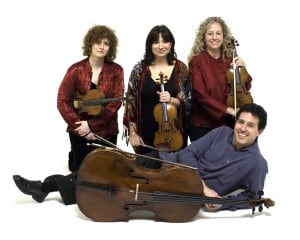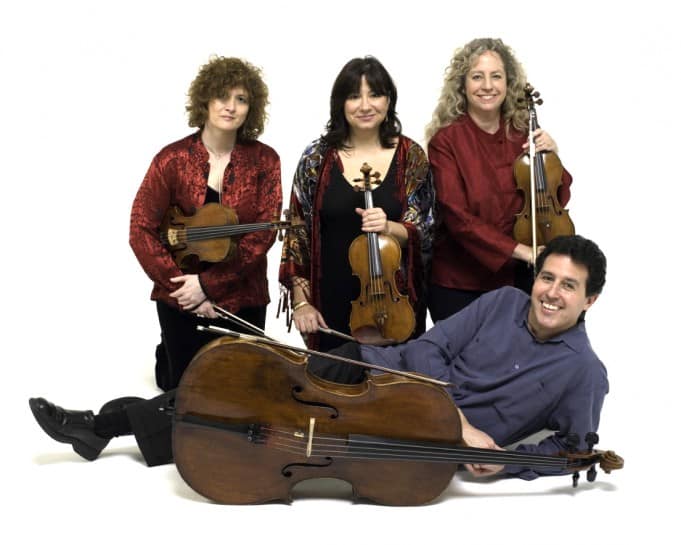 With leaves scudding across the parking lot, crickets chirping and a quarter moon low in the sky, autumn hung in the air on Friday, making one pause to take it in. This was a perfect evening to spend with the Ives Quartet, who performed at St. Marks’s Episcopal in Palo Alto. Even the churchy smell of the heavy wooden beams in the nave and chancel combined with stale incense was perfect,
With leaves scudding across the parking lot, crickets chirping and a quarter moon low in the sky, autumn hung in the air on Friday, making one pause to take it in. This was a perfect evening to spend with the Ives Quartet, who performed at St. Marks’s Episcopal in Palo Alto. Even the churchy smell of the heavy wooden beams in the nave and chancel combined with stale incense was perfect,
This was a particularly delicious program. Often I look at programming and wonder where particular choices came from. With the Ives Quartet, you can almost watch their programming build organically through the year. This concert was no exception. Their first offering, Haydn’s Quartet in E-flat Major, Op. 50, No. 3, built naturally on their September, 2010 and April, 2011 performances, which included Op. 50 No. 1 and 2, respectively. The second offering, Erwin Schulhoff’s Quartet No. 1, was a completion of a performance begun at their September Salon. The third piece, Brahms Quintet in F Minor, Op. 34 brought back a former guest, Gwendolyn Mok, and her 1868 Erard piano. These three pieces complemented each other, combining something light and decorative, with something of profound emotional intensity and something intellectually challenging.
Hearing the Schulhoff a second time in almost as many weeks was a rare treat. I wrote at length about this piece last month, but never heard it live from beginning to end in a single performance. This breathtaking piece opens with an intense presto, punctuated by drone-like cello passages. The second movement highlights the enormous talents of violist Jodi Levitz. I still haven’t figured out how the Ives Quartet produced the breathy tones that sounded all the world like a radio signal fading in and out – sounds that recur in the fourth movement. This piece of great violence and agitation plays like the audio sound track to Hannah Arendt’s Origins of Totalitarianism. The Aviv Quartet and Brandis Quartet versions of this piece – good as they are – don’t hold a candle to the Ives’ version, especially the fourth movement, with it’s eerily oscillating tones played by Susan Frieir.
The star of the show was Gwendolyn Mok’s Erard piano. These words are not an incidental choice, as audience members clustered around the instrument after the show, some even having their picture taken with it. Mok stoked everyone’s interest when she explained the Erard was single strung, instead of cross strung. This difference eliminated some of the overtones that produce a more homogenous sound. Mok drove her point home, contrasting the Erard with a Yamaha grand that shared the stage. Homogenous tone aside, where the Yamaha had a bright tone, the Erard seemed both warmer and clearer.
Mok joined the Ives Quartet for the Brahms Quintet. The enormous contrast in timbre, volume and intensity that the Ives brought to this piece would sound altogether schizophrenic if performed by a lesser group. However, with the Ives Quartet, one marvels at the exquisite integration of piano with quartet, as the sound of one instrument melds into another, one musical gesture is completed by another, sounding at once consonant with each other, and then again, strikingly different. Nowhere is this more evident that the Scherzo, with its intense violence as piano and quartet work at cross-purposes with each other – and then pull together. The frantic, almost march-like scherzo relaxes into a trio – before returning to its original intensity. After this third movement, I was amazed that band members had the energy to continue.
The Ives Quartet will be repeating this program against on Sunday, October 9 at Le Petit Trianon in San Jose.



